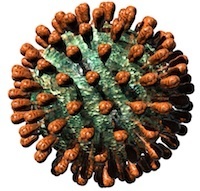
A virus-like particle formed by influenza virus haemagglutinin budding out of plant cells. By Russell Kightley Media
See it also on Scoop.it – Virology News
Our (very) recently-published article on plant-made flu vaccines in BMC Biotechnology:
Setting up a platform for plant-based influenza virus vaccine production in South Africa
Elizabeth Mortimer, James M Maclean, Sandiswa Mbewana, Amelia Buys, Anna-Lise Williamson, Inga I Hitzeroth and Edward P Rybicki
“Background
During a global influenza pandemic, the vaccine requirements of developing countries can surpass their supply capabilities, if these exist at all, compelling them to rely on developed countries for stocks that may not be available in time. There is thus a need for developing countries in general to produce their own pandemic and possibly seasonal influenza vaccines. Here we describe the development of a plant-based platform for producing influenza vaccines locally, in South Africa. Plant-produced influenza vaccine candidates are quicker to develop and potentially cheaper than egg-produced influenza vaccines, and their production can be rapidly upscaled. In this study, we investigated the feasibility of producing a vaccine to the highly pathogenic avian influenza A subtype H5N1 virus, the most generally virulent influenza virus identified to date. Two variants of the haemagglutinin (HA) surface glycoprotein gene were synthesised for optimum expression in plants: these were the full-length HA gene (H5) and a truncated form lacking the transmembrane domain (H5tr). The genes were cloned into a panel of Agrobacterium tumefaciens binary plant expression vectors in order to test HA accumulation in different cell compartments. The constructs were transiently expressed in tobacco by means of agroinfiltration. Stable transgenic tobacco plants were also generated to provide seed for stable storage of the material as a pre-pandemic strategy.
Results
For both transient and transgenic expression systems the highest accumulation of full-length H5 protein occurred in the apoplastic spaces, while the highest accumulation of H5tr was in the endoplasmic reticulum. The H5 proteins were produced at relatively high concentrations in both systems. Following partial purification, haemagglutination and haemagglutination inhibition tests indicated that the conformation of the plant-produced HA variants was correct and the proteins were functional. The immunisation of chickens and mice with the candidate vaccines elicited HA-specific antibody responses.
Conclusions
We managed, after synthesis of two versions of a single gene, to produce by transient and transgenic expression in plants, two variants of a highly pathogenic avian influenza virus HA protein which could have vaccine potential. This is a proof of principle of the potential of plant-produced influenza vaccines as a feasible pandemic response strategy for South Africa and other developing countries.”
I have mentioned time and again that going green is the sensible thing to do: here is a concrete example of how my research group is trying to go about it. This is a very sensible technology for rapid-response vaccine production, and especially for emerging or orphan or pandemic virus threats. We got really good expresion levels of H5N1 HA protein via transient expression in plants, and have already started on pandemic H1N1 HA expression. Let’s hope some governmental types in SA take some notice!
I thank Russell Kightley Media for the specially-commissioned graphic of budded HA-only VLPs.
Tags: biopharming, bird flu, flu, flu vaccine, H5N1, Influenza, plant-based, South Africa
1 November, 2013 at 12:36 |
[…] protein expression work was published in 2012, as well as being featured here in ViroBlogy at the […]